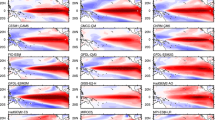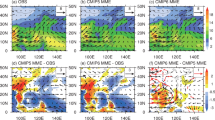Abstract
Realistic simulation of large-scale circulation patterns associated with El Niño-Southern Oscillation (ENSO) is vital in coupled models in order to represent teleconnections to different regions of globe. The diversity in representing large-scale circulation patterns associated with ENSO-Indian summer monsoon (ISM) teleconnections in 23 Coupled Model Intercomparison Project Phase 5 (CMIP5) models is examined. CMIP5 models have been classified into three groups based on the correlation between Niño3.4 sea surface temperature (SST) index and ISM rainfall anomalies, models in group 1 (G1) overestimated El Niño-ISM teleconections and group 3 (G3) models underestimated it, whereas these teleconnections are better represented in group 2 (G2) models. Results show that in G1 models, El Niño-induced Tropical Indian Ocean (TIO) SST anomalies are not well represented. Anomalous low-level anticyclonic circulation anomalies over the southeastern TIO and western subtropical northwest Pacific (WSNP) cyclonic circulation are shifted too far west to 60° E and 120° E, respectively. This bias in circulation patterns implies dry wind advection from extratropics/midlatitudes to Indian subcontinent. In addition to this, large-scale upper level convergence together with lower level divergence over ISM region corresponding to El Niño are stronger in G1 models than in observations. Thus, unrealistic shift in low-level circulation centers corroborated by upper level circulation changes are responsible for overestimation of ENSO-ISM teleconnections in G1 models. Warm Pacific SST anomalies associated with El Niño are shifted too far west in many G3 models unlike in the observations. Further large-scale circulation anomalies over the Pacific and ISM region are misrepresented during El Niño years in G3 models. Too strong upper-level convergence away from Indian subcontinent and too weak WSNP cyclonic circulation are prominent in most of G3 models in which ENSO-ISM teleconnections are underestimated. On the other hand, many G2 models are able to represent most of large-scale circulation over Indo-Pacific region associated with El Niño and hence provide more realistic ENSO-ISM teleconnections. Therefore, this study advocates the importance of representation/simulation of large-scale circulation patterns during El Niño years in coupled models in order to capture El Niño-monsoon teleconnections well.









Similar content being viewed by others
References
Abrol YP, Gadgil S (1999) Rice-in a variable climate. APC Publications Pvt Ltd, New Delhi, p 243
Achuthavarier D, Krishnamurty V, Kirtman BP, Huang B (2012) Role of the Indian Ocean in the ENSO–Indian summer monsoon Teleconnection in the NCEP climate forecast system. J Clim 25:2490–2508. doi:10.1175/JCLI-D-11-00111.1
Annamalai H, Sperber KR (2005) Regional heat sources and the active and break phases of boreal summer intraseasonal (30–50 day) variability. J Atmos Sci 62:2726–2748
Annamalai H, Hafner J, Sooraj KP, Pillai P (2013) Global warming shifts the monsoon circulation drying South Asia. J Clim 26:2701–2718. doi:10.1175/JCLI-D-12-00208.1
Ashrit RG, Kumar KR, Kumar KK (2001) ENSO–monsoon relationships in a greenhouse warming scenario. Geophys Res Lett 28:1727–1730. doi:10.1029/2000GL012489
Bandgar AB, Chowdary JS, Gnanaseelan C (2014) Indian summer monsoon rainfall predictability and variability associated with Northwest Pacific circulation in a suit of coupled model hindcasts. Theor Appl Climatol 118:69–79. doi:10.1007/s00704-013-1051-5
Bhalme HN, Mooley DA (1980) Large-scale drought/floods and monsoon circulation. Mon Weather Rev 108:1197–1211
Bhatt GS (1989) Circulation regimes of rainfall anomalies in the African-South Asian monsoon belt. J Clim 2:1133–1144
Charney JG, Shukla J (1981) Predictability of monsoons. In: Lighthill J, Pearce RP (eds) Monsoon dynamics. Cambridge University Press, Cambridge, pp 99–108
Chen W, Dong B, Lu R (2010) Impact of the Atlantic Ocean on the multidecadal fluctuation of El Niño–southern oscillation–South Asian monsoon relationship in a coupled general circulation model. J Geophys Res 115:D17109. doi:10.1029/2009JD013596
Chowdary JS, Attada R, Lee JY, Kosaka Y et al (2014a) Seasonal prediction of distinct climate anomalies in the summer 2010 over the tropical Indian Ocean and South Asia. J Meteorol Soc Jpn 92:1–16
Chowdary JS, Chaudhari HS, Gnanaseelan C, Parekh A, Suryachandra Rao A, Sreenivas P, Pokhrel S, Singh P (2014b) Summer monsoon circulation and precipitation over the tropical Indian Ocean during ENSO in the NCEP climate forecast system. Clim Dyn 42:1925–1947. doi:10.1007/s00382-013-1826-5
Chowdary JS, Bandgar AB, Gnanaseelan C, Luo J-J (2015) Role of tropical Indian Ocean air–sea interactions in modulating Indian summer monsoon in a coupled model. Atmos Sci Let 16:170–176
Compo GP et al (2011) The twentieth century reanalysis project. Quart J Roy Meteor Soc 137:1–28
Du Y, Xie SP, Yang YL, Zheng XT, Liu L, Huang G (2013) Indian Ocean variability in the CMIP5 multimodel ensemble, the basin mode. J Clim 26:7240–7266. doi:10.1175/JCLI-D-12-00678.1
Francis PA, Gadgil S (2010) Towards understanding the unusual Indian monsoon in 2009. Journal of Earth System Science 119:397–415
Gadgil S, Srinivasan J, Nanjundiah R, Krishna Kumar K, Munot AA, Rupa Kumar K (2002) On forecasting the Indian summer monsoon: the intriguing season of 2002. Curr Sci 83:394–403
Gadgil S, Vinayachandran PN, Francis PA (2003) Droughts of the Indian summer monsoon: role of clouds over the Indian Ocean. Curr Sci 85:1713–1719
Gill AE (1980) Some simple solutions for heat-induced tropical circulation. Q J R Meteorol Soc 106(449):447–462. doi:10.1256/smsqj.44904
Huffmann GJ, Adler RF, Rudlof B, Schneider U, Keehn PR (1995) Global precipitation estimates based on a technique for combining satellite-based estimates, rain gauge analysis, and NWP model precipitation information. J Clim 8:1284–1295
Kinter JL, Miyakoda K, Yang S (2002) Recent changes in the connection from the Asian monsoon to ENSO. J Clim 15:1203–1214
Kripalani RH, Kulkarni A, Sabade SS (2003) Indian monsoon variability in a global warming scenario. Nat Hazards 29:189–206
Krishna Kumar K, Rajagopalan B, Cane A (1999) On the weakening relationship between the Indian monsoon and ENSO. Science 284:2156–2159
Li X, Ting M (2015) Recent and future changes in the Asian monsoon-ENSO relationship: natural or forced? Geophys Res Lett 42. doi:10.1002/2015GL063557
Li G, Xie SP (2012) Origins of tropical-wide SST biases in CMIP multi-model ensembles. Geophys Res Lett 39:L22703. doi:10.1029/2012GL053777
Li G, Xie SP, Du Y (2015) Monsoon-induced biases of climate models over the tropical Indian Ocean. J Clim 28:3058–3072
Li G, Xie SP, Du Y (2016) A robust but spurious pattern of climate change in model projections over the tropical Indian Ocean. J Clim 29:5589–5608
Matsuno T (1966) Quasi-geostrophic motions in the equatorial area. J Meteor Soc Japan 44(1):25–43
Meehl GA (1987) The annual cycle and interannual variability in the tropical Pacific and Indian Ocean region. Mon Wea Rev 115:27–50
Normand C (1953) Monsoon seasonal forecasting. Q J R Meteorol Soc 79:463–473
Ojha S, Gnanaseelan C, Chowdary JS, Parekh A, Rahul S (2016) Arabian Sea SST evolution during spring to summer transition period and the associated processes in coupled climate models. Int J Climatol 36:2541–2554. doi:10.1002/joc.4511
Pai D, Sridhar L, Badwaik MR, Rajeevan M (2014) Analysis of the daily rainfall events over India using a new long period (1901–2010) high resolution (0.25° × 0.25°) gridded rainfall data set. Clim Dyn. doi:10.1007/s00382-014-2307-1
Pant GB, Parthasarathy SB (1981) Some aspects of an association between the southern oscillation and Indian summer monsoon. Arch Meteor Geophys Bioklimatol 29(B):245–252. doi:10.1007/BF02263246
Preethi B, Revadekar JV, Kripalani RH (2011) Anomalous behaviour of the Indian summer monsoon 2009. J Earth Syst Sci 120(5):783–794
Rajeevan M, Bhate J, Kale JD, Lal B (2006) High resolution daily gridded rainfall data for the Indian region: analysis of break and active monsoon spells. Curr Sci 91:296–306
Rasmusson EM, Carpenter TH (1983) The relationship between eastern equatorial Pacific sea surface temperatures and rainfall over India and Sri Lanka. Mon Weather Rev 111:517–528
Rayner NA, Parker DE, Horton EB, Folland CK, Alexander LV, Rowell DP, Kent EC, Kaplan A (2003) Global analyses of sea surface temperature, sea ice, and night maritime air temperature since the late nineteenth century. J Geophys Res 108:4407. doi:10.1029/2002JD002670
Roy I, Tedeschi RG (2016) Inluence of ENSO on regional Indian summer monsoon precipitation–local atmospheric inluences or remote inluence from Paciic. Atmosphere 7:25
Saji NH, Goswami BN, Vinayachandran PN, Yamagata T (1999) A dipole mode in the tropical Indian Ocean. Nature 401:360–363. doi:10.1038/43854
Schneider T, Bischoff T, Haug GH (2014) Migrations and dynamics of the intertropical convergence zone. Nature 513:45–53. doi:10.1038/nature13636
Shukla J, Paolino DA (1983) The southern oscillation and long range forecasting of the summer monsoon rainfall over India. Mon Weather Rev 111:1830–1837
Sikka DR (2003) Evaluation of monitoring and forecasting of summer monsoon over India and a review of monsoon drought of 2002. Proceedings of the National Academy of Sciences India, Section A 69:479–504
Sperber KR, Annamalai H, Kang IS, Kitoh A, Moise A, Turner A, Wang B, Zhou T (2012) The Asian summer monsoon: an intercomparison of CMIP5 vs. CMIP3 simulations of the late 20th century. Clim Dyn. doi:10.1007/s00382-012-1607-6
Taylor KE, Stouffer RJ, Meehl GA (2012) An overview of CMIP5 and the experiment design. Bull Am Meteorol Soc 90:485–498
Turner AG, Annamalai H (2012) Climate change and the South Asian summer monsoon. Nat Climate Change 2:587–595. doi:10.1038/nclimate1495
Varikoden H, Singh BB, Sooraj KP, Joshi MK, Preethi B, Mujumdar M, Rajeevan M (2015) Large scale features of southwest monsoon during 2015, Chapter 1, A research report on the 2015 Southwest Monsoon edited by Mujumdar M, Gnanaseelan C and M Rajeevan. IITM research report, ISSN 0252–1075
Walker GT (1923) Correlation in seasonal variations of weather, a preliminary study of world weather. Mem Indian Metcorol Dept 24:75–131
Walker GT (1924) Correlation in seasonal variations of weather. I V a further study of world weather. Mem Indian Meteorol Dept 24:275–332
Webster PJ, Yang S (1992) Monsoon and ENSO, selectively interactive systems. Q J R Meteorol Soc 118:877–926
Webster PJ, Magaña V, Palmer TN, Shukla J, Tomas RA, Yanai M, Yasunari T (1998) Monsoons: processes, predictability and the prospects for prediction. J Geophys Res 103:14451–14510
Xie SP, Hu K, Hafner J, Tokinaga H, Du Y, Huang G, Sampe T (2009) Indian Ocean capacitor effect on indo-western Pacific climate during the summer following El Niño. J Clim 22:730–747
Yang J, Liu Q, Xie SP, Liu Z, Wu L (2007) Impact of Indian Ocean SST basin mode on the Asian summer monsoon. Geophys Res Lett 34:L02708. doi:10.1029/2006GL028571
Yasunari T (1990) Impact of Indian monsoon on the coupled atmosphereiocean system in the tropical Pacific. Meteorog Atmos Phys 44:29–41
Acknowledgements
We are grateful to the Director of Indian Institute of Tropical Meteorology (IITM) for support. The authors also thank India Meteorological Department (ncc@imd.gov.in). We thank the anonymous reviewers for the comments, which helped us to improve the manuscript. We are very thankful to Dr. Terry Pascal for language correction and suggestions. We acknowledge the World Climate Research Programme’s Working Group on Coupled Modeling, which is responsible for CMIP, and we thank the climate modeling groups for producing and making available their model outputs. For CMIP, the US Department of Energy’s Program for Climate Model Diagnosis and Intercomparison provides coordinating support and led the development of software infrastructure in partnership with the Global Organization for Earth System Science Portals. We thank the NCAR for making available the NCAR Command Language (NCL). All data sources are duly acknowledged.
Author information
Authors and Affiliations
Corresponding author
Rights and permissions
About this article
Cite this article
Ramu, D.A., Chowdary, J.S., Ramakrishna, S.S.V.S. et al. Diversity in the representation of large-scale circulation associated with ENSO-Indian summer monsoon teleconnections in CMIP5 models. Theor Appl Climatol 132, 465–478 (2018). https://doi.org/10.1007/s00704-017-2092-y
Received:
Accepted:
Published:
Issue Date:
DOI: https://doi.org/10.1007/s00704-017-2092-y




